

Page Emphasizes Innovation at Panel on Dell Medical School
The Austin Chapter of the Institute for Leadership in Capital Projects (I-LinCP) brought together key stakeholders to discuss their perspectives on the Dell Seton Medical Center at The University of Texas at Austin. The district is made up of the Dell Medical School, which comprises three new buildings and a parking garage totaling more than 590,000 square feet, and the Dell Seton Medical Center, another 500,000 square-foot healthcare facility including a teaching hospital and a Level 1 Trauma Center. Citing the project’s unprecedented community partnership, I-LinCP asked major players to discuss project benefits and key lessons learned during the initial phase of construction.
Page Principal and Project Director for the Dell Medical School Research and Office Building Brian Roeder was part of the panel discussion that followed introductions by President of Dell Seton Medical Center at The University of Texas, University Medical Center Brackenridge and Seton Shoal Creek Hospital Christann M. Vasquez and Senior Project Manager The University of Texas System Office of Facilities Planning and Construction Jim Shackelford.
Vasquez concentrated on redefining the patient experience while “putting a little bit of Austin” into the building designs. Shackelford focused on the primary design challenges, which included complying with the Capitol View Corridors ordinance as well as solving problems presented by the flood plain and Waller Creek. The ensuing panel discussion, which Page’s Roeder participated in also included Operations Manager of Hensel Phelps Dwight Runkels and Vice President of Operations for JE Dunn Greg Euston.
After a lively discussion, the panel concluded with Roeder emphasizing the push for innovation at the medical school. “The Health Transformation Building is approaching clinical healthcare from very much an academic approach,” he said. “It's a place for learning, experimentation and trials. Rooms are not set to standard size but rather will have moveable walls and can accommodate distinct set ups and integrated practice unit concepts. The Dell Medical School can then assess what works and what doesn’t with hard data and user feedback. Over time the integrated practice module can adjust how medical delivery changes, all with the underlying concept to improve the patient experience.”
06/16/2016
People
- Daniel Brooks
- Robert E. Burke
- Ginny Chilton
- Joshua D. Coleman
- Mattia J. Flabiano III
- Patrick Gurley
- Breanne Hanson
- Shawn-Marie Henson
- Jeffrey G. Jewesson
- Matthew Z. Leach
- Ryan Losch
- Joseph P. Moore
- Erin D. Nash
- Bryan O'Sullivan
- Freddy Padilla
- Dale Robinson
- Brian D. Roeder
- Sana Sabharwal
- Kimberly Schuessler
- Jerald L. Segner
- Jonah T. Sendelbach
- Talmadge Smith
- Lawrence W. Speck
- Wendy Dunnam Tita
- Randy C. Twedt
Related Posts
- A District Built For Health
- Tempering the Temporary: Improving thermal comfort and safety in relief shelters
- Ushering in New Era of Science Research
- Nurturing Resiliency through Relationships
- Overview: Dell Medical School at The University of Texas at Austin Updates
- Winner: Community Impact Award
- New School of Thought at New School of Medicine








